Nothing Found
Sorry, no posts matched your criteria
Sorry, no posts matched your criteria

Melbourne car dealer Nick Zhao may or may not have been approached by Chinese state operatives offering $1 million for the Liberal Party member to run for parliament. He’s dead and a coronial inquiry is underway. The new head of the Australian Security Intelligence Organisation, Mike Burgess, has said that ‘Australians can be reassured that ASIO was previously aware of matters that have been reported today, and has been actively investigating them.’ That’s good, if sobering, news because it tells us the allegations published in The Age and Sydney Morning Herald and aired on 60 Minutes are credible.
And apparent defector Wang Liqiang may or may not be an intelligence operative who worked for the Chinese Communist Party to compromise and disrupt pro-democracy students and groups in Hong Kong and who ran similar activities to disrupt Taiwan’s democracy. Wang has also reportedly said spies from Beijing were ‘operating with impunity in Australia’.
On Zhao, details are sketchy, so we’ll need to hear the results of the coronial inquiry and ASIO’s investigation.
With Wang, however, his account of the Chinese state’s covert work to interfere in Hong Kong and in Taiwanese and Australian politics came with reams of public detail. What he’s revealed aligns well with things we already know about Chinese intelligence work. What’s new is that he’s added important details on individuals, companies, places, times and activities which can be followed up. For ASIO, this will provide leads to better understand and disrupt this covert and corrupting Chinese state activity.
We can be pretty confident Wang is who he says he is and the Chinese agencies, companies and operatives he worked with did what he says they did. That’s even more likely given the Chinese embassy’s rapid denouncement of Wang that quoted a hastily issued statement from Shanghai police after Wang’s allegations were first reported. There’s no record of his supposed fraud conviction before the statement was issued and it seems like the kind of coverup you’d expect when a Chinese intelligence operation is compromised.
What does all this mean? Put bluntly, it shows that outgoing ASIO boss Duncan Lewis was spot on when he observed in September that terrorism had plateaued as a threat, but foreign interference was ‘on a growth path’. He noted that, ‘Unlike the immediacy of terrorism incidents, the harm from acts of espionage may not be present for years, even decades, after the activity has occurred. These sorts of activities are typically quiet, insidious and have a long tail.’ That’s an insight our political leaders and the broader Australian public need to take to heart.
Let’s suppose the alleged plan to get Zhao into parliament had actually worked. He would’ve been a Liberal backbencher working diligently on constituency issues in the Melbourne seat of Chisholm and showing his potential. Two or three elections from now, he might have aspired to an outer ministry and later, perhaps, higher things. An ability to bring in plenty of cash to the party over that time, no doubt with help from his Chinese government handlers, wouldn’t have hurt. That’s the kind of ‘long tail’ damage Lewis was talking about.
Every Australian political party now needs to take the threat of Chinese covert interference in our democracy seriously and work with government agencies to reduce the prospects that our public debate and our parliamentary decision-making will be compromised. It’s not undemocratic for the Greens, the Liberals, Labor and the Nationals to take advantage of the knowledge and expertise of Australia’s national security agencies.
In the face of well-organised and lavishly funded interference from President Xi Jinping’s powerful authoritarian state it’s essential to protect the vibrancy and independence of our political system. It’s also worth noting that our Australian Chinese community is not even the most likely place to look for political figures who might be candidates for long-term cultivation.
Nowadays, it’s almost routine for former politicians and senior civil servants involved in the public debate on China to be performing advisory work for or receiving sponsorship from Chinese entities. Many of these entities are harmless, but some, no doubt, have close links to CCP institutions that these public voices and the Australian public need to understand, not dismiss. Remember it was the scandal around former Labor senator Sam Dastyari—not a Chinese Australian—that crystallised a series of events ending in the passage of the foreign interest transparency law by a thumping bipartisan majority in August last year. That law doesn’t yet cover politicians and their staff—a glaring gap that must now be closed.
Finance Minister Mathias Cormann was right to say we would be ‘getting a bit ahead of ourselves’ to suggest the government complain to Beijing over the allegations about Zhao. Refreshingly, he went on to say that ‘issues will arise that need to be dealt with and where there is bad and inappropriate conduct, we will call that out and seek to have that addressed’. He emphasised that ASIO’s investigation needs to take its proper course.
In contrast to the case of Chinese state hacking into our parliament and three major political parties earlier this year, once this investigation is complete Burgess needs to take the same approach he took as head of the Australian Signals Directorate and come out of the shadows. That’d be best done with him sitting in a booth in parliament while Prime Minister Scott Morrison or Home Affairs Minister Peter Dutton makes a public statement on the topic.
The sensitive and corrosive issue of Chinese state interference in our democracy needs to be handled in a calm and orderly way. At the same time, the government must be honest and open with the Australian people about the challenge we are facing and how it is being dealt with.
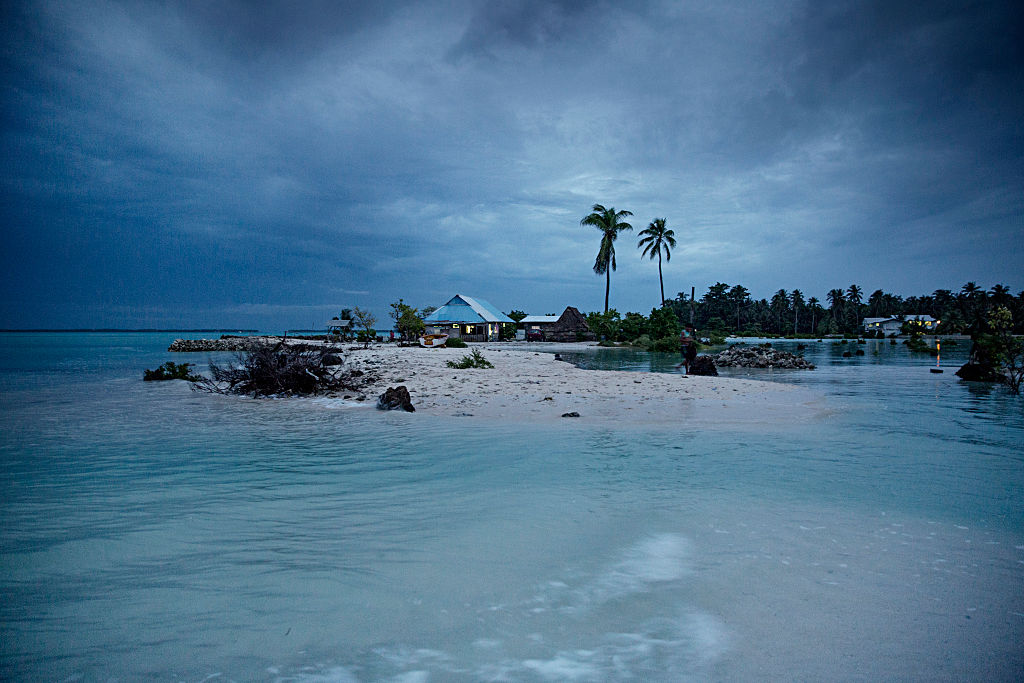
On 11 November, California and 22 other US states sued the US Environmental Protection Agency, requesting that a federal appeals court block the Trump administration’s revocation of a Clean Air Act waiver that has historically allowed California to set its own, more stringent vehicle emissions regulations.
While the White House finds itself fending off litigious state attorneys domestically, its continued tone-deafness to global climate concerns could also cripple US engagement in the Pacific—at a time when Beijing is making inroads throughout the region.
Last year, China eyed a permanent presence in Vanuatu, wary of strategic encirclement by American and allied militaries, and eager to expand its own navy’s range and basing options.
And this September, in a celebrated coup for Beijing, Solomon Islands and Kiribati each switched their diplomatic allegiance from Taiwan to the People’s Republic of China. Of Taipei’s remaining 15 international partners, four are Pacific island states.
Commentators see the opening moves of a global chess game between China and the US, speak of island countries falling like dominos, or even evoke the 19th-century scramble for influence in central Asia by calling this emerging dynamic the ‘Pacific Great Game’.
But an obsessive focus on diplomatic poaching or military balancing overlooks the primary concern of islanders.
In a scathing Sydney Morning Herald op-ed, Reverend James Bhagwan, general secretary of the Pacific Conference of Churches, made clear that in the Pacific’s fragile islands, ‘nothing worries us more than climate change’.
Bhagwan noted that Pacific islanders ‘have long asked industrialised nations to stop burning fossil fuels and to do more to help the Pacific adapt’, and he specifically excoriated Australian Prime Minister Scott Morrison for opening new territory in Queensland to coal mining and for employing ‘accounting tricks to create the illusion’ of satisfying Australia’s emissions targets.
Fiji’s prime minister, Frank Bainimarama, tweeted at Morrison last year that climate change is ‘the greatest threat facing Australia and all of your neighbors in the Pacific’.
In August, Australia promised $500 million over five years to Pacific islands, earmarked for projects related to climate change and natural disaster resilience. Later that week, however, the Pacific Islands Forum was tainted by heated arguments and even tears over the concluding communiqué’s watered-down language on global warming. According to Kiribati’s former president Anote Tong, Australia’s delegation seemed chiefly concerned with safeguarding its coal industry, and Tuvalu’s then-PM Enele Sopoaga chided Australia for forgetting ‘the spirit of the Pacific way’. Both leaders suggested that Australia be suspended or sanctioned from future gatherings.
American diplomats should be thankful that similar acrimony hasn’t also been extended towards President Donald Trump—at least not yet.
Provisions of the Paris climate agreement prevent a US withdrawal until November 2020, though at a recent natural gas industry conference in Pittsburgh, Trump confirmed his intention to abandon his predecessor’s emissions-reduction pledge.
The US Justice Department has initiated an antitrust investigation into four automakers that had cooperated with California on stricter fuel economy standards, and also filed suit over a carbon cap-and-trade framework that included Quebec, Canada, explaining that California ‘veered outside of its proper constitutional lane’ by entering into an international emissions agreement.
Beijing, to its credit, recognises the value of environmental rhetoric. In coverage of a recent economic development summit in Samoa, the state-run Xinhua news agency touted China as ‘one of the first countries to sign the Paris Agreement’ and highlighted its pledge ‘to halt the rise in carbon dioxide emissions by around 2030’.
Omitted, of course, was China’s title as the world’s largest greenhouse gas emitter and coal consumer, and that its carbon dioxide output grew by 4% during the first half of this year.
Public diplomacy efforts should seek to spotlight Chinese environmental recklessness, such as the release of thousands of tons of ozone-depleting chlorofluorocarbons in northeast China in violation of the Montreal Protocol, and China’s ongoing plans to construct more than 300 coal-fired power plants around the world. Beijing would surely call such finger-pointing hypocritical, but such a campaign could nonetheless redirect some of the Pacific’s ire towards China and create awkwardness for Beijing’s envoys.
Some of the most compelling climate interlocutors with Pacific islands, however, may prove to be US defence officials. A 2010 military study cited climate change as ‘one of the ten trends most likely to impact the Joint Force’, and in 2014, the Department of Defense released a climate adaptation roadmap, aiming to keep pace with worrisome climate effects. This past January, a departmental assessment found two-thirds of listed military installations vulnerable to present or future recurring flooding, with half at risk from drought.
Defence attachés, representatives from the US Indo-Pacific Command, and officers who exercise with their Pacific island counterparts should seek opportunities to discreetly discuss the US military’s decade-old acknowledgement of climate change and ramifications for defence infrastructure, readiness and operations. While the White House may thumb its nose at climate ‘alarmists’, military leaders should sympathise when face-to-face with Pacific partners, to communicate genuine US concern and relate mitigation strategies.
But, ultimately, if the Trump administration wants to maximise its credibility among Pacific island countries, and to garner the trust and favour of the region’s residents, it will need to abandon its opposition to state-initiated emissions reductions and demonstrate authentic efforts to forestall climate change.
Otherwise, in islands acutely threatened by a warming climate, American overtures may be greeted with a downright frigid reception.
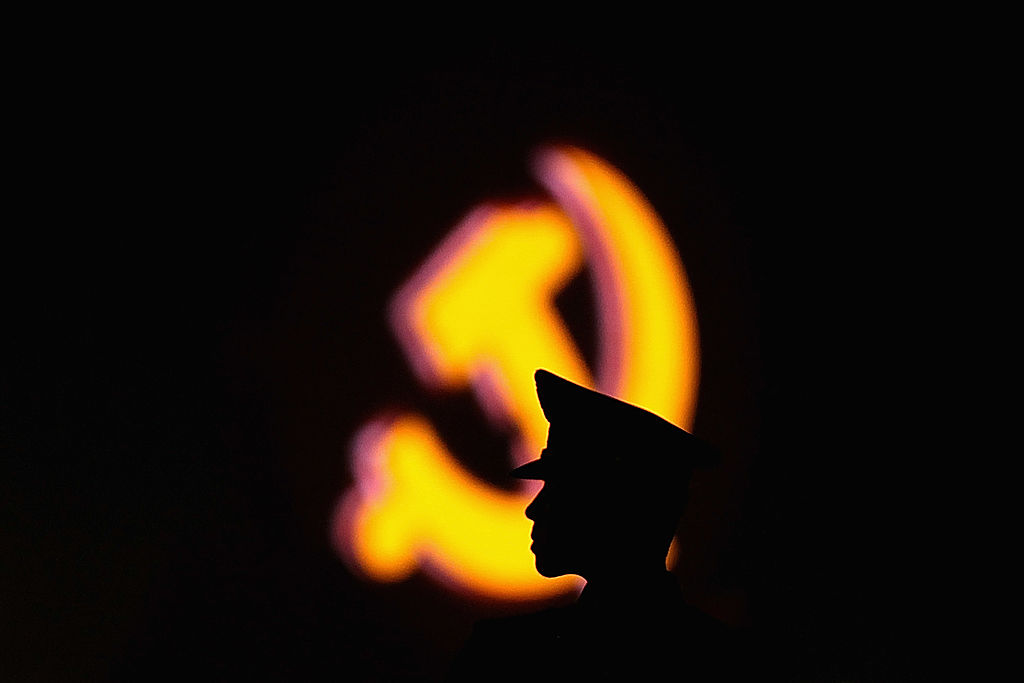
In this special episode, ASPI Executive Director Peter Jennings and Defence, Strategy and National Security Director Michael Shoebridge discuss the unprecedented leak of hundreds of pages of internal Chinese government documents.
The trove of information was revealed by the New York Times and shows details behind the program of the mass incarceration of Muslims in Xinjiang.
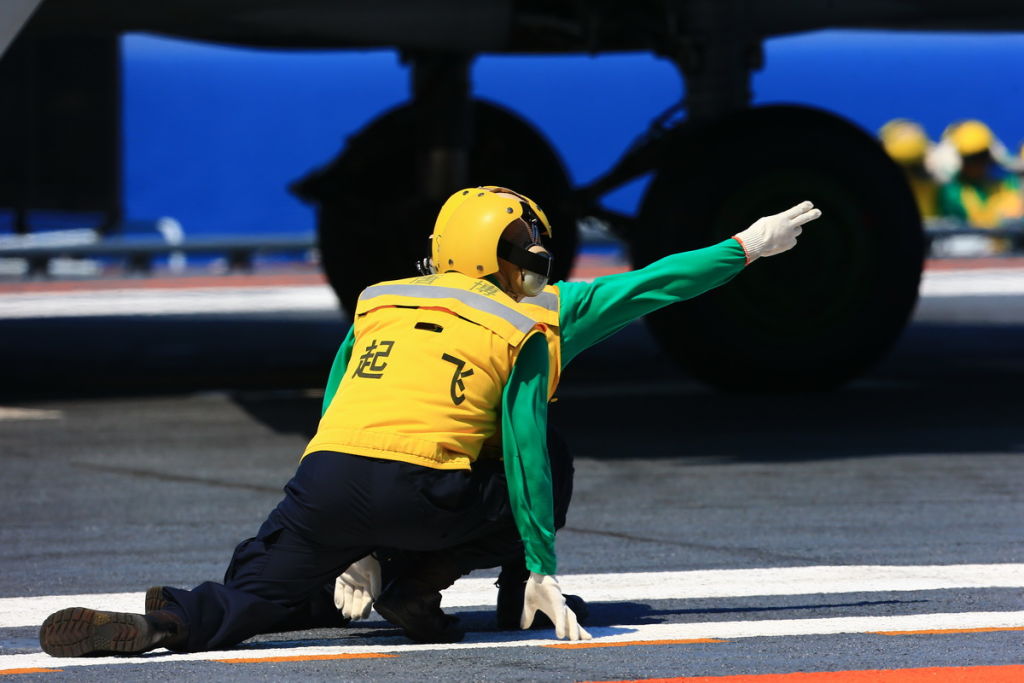
The Great Game was played by Great Britain and Russia throughout the 19th century and reflected the two powers’ political and strategic jostling for influence across Central Asia. It was essentially about geographic positioning, and a 21st-century version is now being played in the South Pacific. The outcome will change the strategic balance across Asia and most of the Pacific. Australia needs to consider how to position itself in this contest in order to shape what’s likely to be a significantly altered strategic landscape.
On one side is China, cashed up, with a clear strategic direction and a willingness to play over the long term. It is also willing to play by a completely different set of rules. On the other side is a grouping of players, spread across the Pacific. There are Japan and South Korea, which don’t seem to know they’re in the game, but will be significantly affected by the outcome. There’s the United States, at the moment the best player, trained up, with the best kit, but increasingly disinterested and in more of a mind to just go home. Then there’s Australia, wanting to play alongside the US but not able either to convince America to stay in the game or to play alone.
The latest moves by Australia and China are illustrative. Australia’s was two-pronged: to re-establish a naval base at Manus Island and to comprehensively engage the South Pacific island states. The jury is out on the effectiveness of the first move and the second was a partial own goal. Manus Island was intended to be a mechanism to bring the US more into the game while providing a forward base for surveillance of regional developments. The Pacific islands move was warranted, albeit late, but the lack of commitment by Canberra to address climate change has arguably harmed some relationships, particularly in countries facing an existential threat from rising sea levels.
The latest China move builds on the position gained through the developments in the South China Sea, centred on militarising a string of artificial islands and on the build-up of anti-access/area-denial (A2/AD) systems. China has given itself the capability to essentially close the sea routes across this important area in situations short of war.
China’s strategy is to build a permanent presence in the Southwest Pacific, a move made clearer and more real by an attempt by China, since deemed illegal, to lease the entire island of Tulagi in Solomon Islands for 75 years. The importance of that move to the players is brought into stark relief by a map from the Center for Strategic and International Studies’ ChinaPower project, reproduced below. It highlights the impact of the progressive denial of the archipelagic straits and the South China Sea to shipping.
If all these routes are closed, the strategic value of the South Pacific islands will be elevated. Traffic to Japan and South Korea will have to travel even further out into the Pacific, the ability of the US to manoeuvre freely will be affected, and Australia may be isolated from our increasingly reluctant ally.
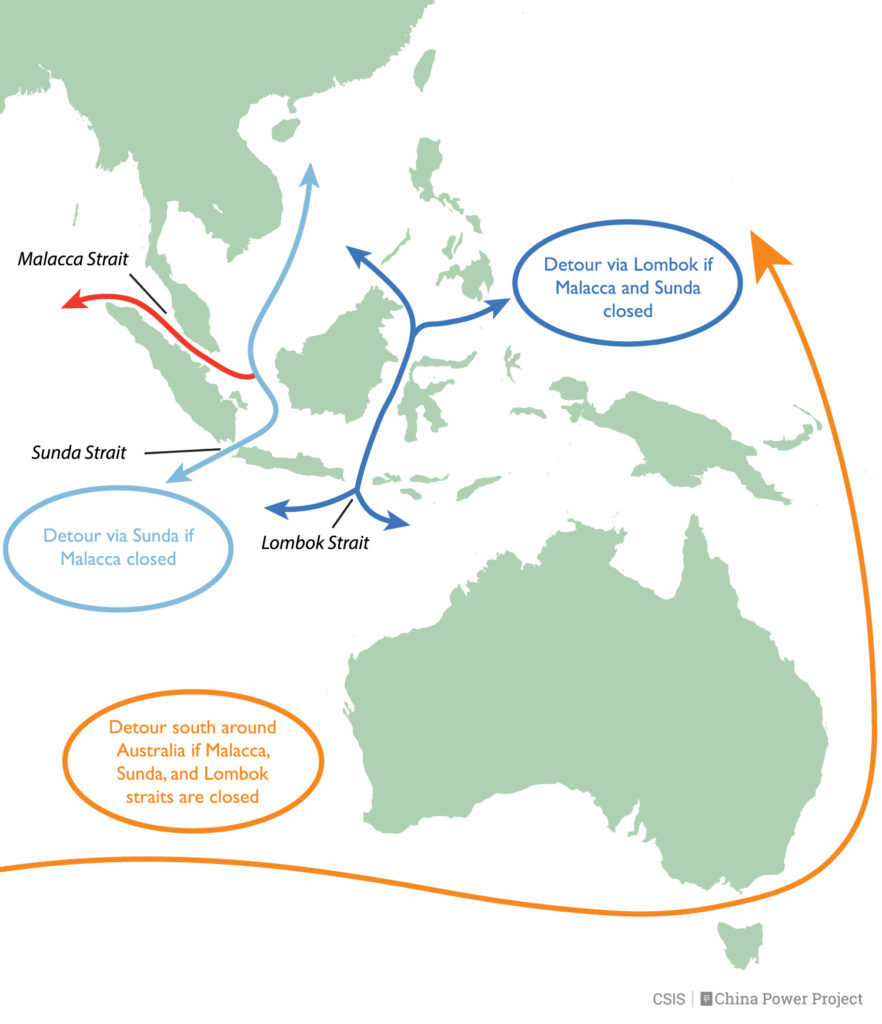
Source: China Power Team, ‘How much trade transits the South China Sea?’, 2 August 2017; updated 10 October 2019.
The next Australian move in the game is crucial and needs to take advantage of geography and not just be dictated by it. The priorities should be to:
Australia needs to prepare for a more independent defence industry as an increasingly isolationist United States is less likely to come to our aid. We need to have real sovereignty over the strategically important aspects of our military capability. That means matching defence industry capabilities with the military forces considered critical to our defence strategy.
Australia is steadily being outflanked and outgunned. The main game in the Pacific has always been a maritime one. Both Japan and the US understood that during World War II. China obviously also seems to understand it today. Our defence and foreign affairs strategies need to evolve to reflect this reality. We simply don’t have the funds to outbid China in this area. We need to understand and more meaningfully engage with the South Pacific nations, beyond defence cooperation. This includes a fundamental recognition of the threat posed by climate change to South Pacific island states.

Although the rapid escalation of violence in Hong Kong seems terrifying enough, things may be about to get much worse. The communiqué of the recently concluded fourth plenum of the 19th Central Committee of the Chinese Communist Party indicates that President Xi Jinping is planning to tighten his grip on the former British colony at any cost. He should prepare to rack up a formidable bill.
The communiqué includes two ominous pledges. First, China’s central government will ‘control and rule’ (guanzhi) Hong Kong (and Macau) using ‘all the powers vested in [it] under the constitution and the Basic Law’, the mini-constitution that defines Hong Kong’s status. Second, it will ‘build and improve a legal system and enforcement mechanism to defend national security’ in both special administrative regions.
A few days after the plenum, the CCP’s plan to assert its control over Hong Kong became clearer when it released the full text of the resolution endorsed there by its central committee. China’s central government intends to change the process for appointing Hong Kong’s chief executive and key officials, and reform the system governing how the Chinese National People’s Congress Standing Committee interprets the Basic Law. Moreover, China will support the strengthening of Hong Kong’s law-enforcement capabilities and ensure that the city government enacts legislation to enhance national security. It will also deepen Hong Kong’s economic integration with the mainland and expand ‘education’ programs to cultivate a ‘national consciousness and patriotic spirit’, especially among civil servants and young people.
Though the details of the plan have yet to be worked out, it seems evident that China’s leaders intend to gut the Basic Law, exercise more direct control over the appointment of key officials, weaken or eliminate Hong Kong’s judicial independence, curtail civil liberties and suppress political dissent, including through ideological indoctrination. In other words, they have decided effectively to abandon the ‘one country, two systems’ model, which Deng Xiaoping promised to uphold for 50 years after Hong Kong’s return to Chinese rule in 1997.
China’s leaders must know that they will run into powerful resistance. While some initial steps will be taken in Beijing, the plan’s most substantive measures will require action on the ground in Hong Kong. And if the ongoing protests have shown anything, it’s that Hong Kong’s people won’t go down without a fight.
In fact, China has tried to get Hong Kong’s legislative council to pass national security legislation before, in 2003, but more than half a million residents took to the streets to protest, forcing the government to withdraw the bill. Likewise, China’s attempt in 2012 to institute ‘patriotic education’ in Hong Kong by changing its history textbooks ignited a rebellion among parents and students, forcing the government to back down.
As the CCP attempts to exert total control over Hong Kong, even larger demonstrations, marked by even more violence, are likely. The city will descend further into chaos and become ungovernable. But that may well be what China’s leaders want: an excuse to deploy security forces and impose direct control over the city. In that sense, the fourth plenum may mark the beginning of the end of Hong Kong as we know it.
What Xi and the CCP seem not to understand is how much this approach will hurt them. After all, China is likely to lose much of its access to the global financial system as countries revise their relationships with the new Hong Kong.
Already, the US House of Representatives has adopted a bill that, if also passed by the Senate, would mandate an annual review by the State Department to determine whether Hong Kong remained sufficiently autonomous to justify its special trading status under US law. As China’s central government tramples on Hong Kong’s rights, more Western democracies—including those that have hesitated to support US President Donald Trump’s efforts to contain China—are likely to support comprehensive economic sanctions.
It should be obvious that this would be a devastating development for Xi and the CCP, whose legitimacy depends on continued economic growth and improvements in living standards. But in a country whose top leadership brooks no dissent, there are few safeguards against bad policymaking.
Two years ago, Xi declared that by the time the People’s Republic of China celebrates its centenary in 2049, it should be a ‘great modern socialist country’ with an advanced economy. The fourth plenum communiqué reiterated this objective. But if China’s central government reneges on its obligations to Hong Kong, that goal is likely to become little more than a distant dream.
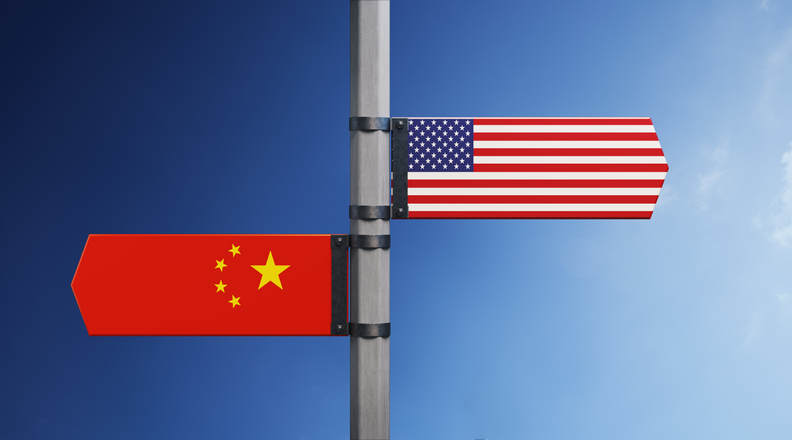
Language and rhetoric are important in a time of consequential power shifts and may even form a key front in Asia’s great-power rivalry—especially now, looking at US strategy in the region. Washington’s declared strategy of a free and open Indo-Pacific—despite what the name suggests—still struggles to convince that it has transitioned from mere rhetoric into genuine action.
The pulse of the regional debate suggests that there are now four dominant—albeit misleading—narratives in Southeast Asia about great-power competition and the differing roles of China and the US.
The first is the push-back against a paradigm of great-power competition in which smaller states are compelled to choose between Washington and Beijing. The narrative of choice isn’t a new one, but it has gained currency particularly among the ASEAN leaders over the past year. At the 2018 ASEAN summit, Singapore’s Lee Hsien Loong declared that making such a choice might be unavoidable. ‘Circumstances may come where ASEAN could have to choose one over the other,’ he said.
Some six months later, as the debate intensified, Singapore’s PM steadfastly resisted the notion that the region should have to choose. In a keynote speech at the 2019 Shangri La Dialogue, Lee stressed that Singapore wants to be friends with both, rather than choose one over another. This view is not exclusive to Singapore; as a recent report from the Brookings Institution, Don’t make us choose, makes clear, it’s now widespread across ASEAN.
While this narrative narrowly—and falsely—frames the choice as either/or, it does reflect a level of anxiety about the impact of growing great-power competition and resistance to the return of bipolarity. While Beijing has a track record in pushing binary choices, the debate has shifted the focus onto the US. Now it appears that Washington is the great power that’s asking states in the region to choose.
US Vice President Mike Pence and Secretary of State Mike Pompeo have appeared to convey the following message at previous regional summits and in public speeches: ‘Don’t go for the debt-trap diplomacy of the Belt and Road Initiative. The free and open Indo-Pacific is a much better alternative to the Sino-centric regional order.’ The Huawei ban declared by the US and some of its closest allies also involves regional fears about a new technology iron curtain. Rather than seeing viable and attractive alternatives, more often than not Southeast Asia sees having to choose as an imposition.
Indeed, the Trump administration’s language fuels this interpretation. The narrative also misleadingly suggests that all other actors are destined to fall victim to the great-power contest and that they have no, or little, power to influence events. In fact, the US–China choice serves different purposes for some of the Southeast Asian states in manoeuvring in a tenser strategic environment—a development that deserves a separate analysis. But that doesn’t change the fact that this narrative is being popularised.
When it comes to ASEAN’s relations with China, another dominant refrain is the narrative of destiny.
The tyranny of cartographic reality, aggravated by the sheer power asymmetry, translates to a kind of strategic fatalism—an assumption, however unwillingly, that there’s no option other than working with Beijing. The alternative—confronting it—is simply undesirable, if not unacceptable to some.
This applies even to the giant of Southeast Asia, Indonesia. The country’s newly re-elected president, Joko Widodo, was quoted as saying, ‘There is no choice but cooperate and co-exist.’
Philippine President Rodrigo Duterte—whose country won an unprecedented international legal action over a maritime dispute with China—has on many occasions expressed the logic behind his government’s failure to pursue maritime territorial claims. ‘What can we do? Go to war with China? Educate me please’, he has said.
At the ASEAN summit last week, Malaysia’s veteran prime minister, Mahathir Mohammad, said: ‘We pointed out that we are a small country. [We] can’t confront China. If they want to claim [the] South China Sea as theirs, that’s their concern.’
This narrative bears a striking resemblance to the words uttered by Chinese Foreign Minister Yang Jiechi at the ASEAN Ministerial Meeting in Hanoi in 2010, when he reminded his counterparts in the region that ‘China is a big country and other countries are small countries, and that’s just a fact.’
It flows from a recognition that China will continue to play by far the most significant economic role in Southeast Asia—something that concerns each and every country, regardless of their political relations with China.
A regional survey conducted by the ISEAS-Yusof Ishak Institute reflects this reality, with over 73% of respondents seeing China as having the most economic influence in Southeast Asia compared with only 7.9% who thought the same about the US. This is despite the fact that US direct foreign investment in the region remains higher than that of China.
China’s geostrategic shadow looms large over Southeast Asia and promises an intertwined economic future. The notion of a common destiny with Beijing, accompanied by a certain sense of strategic fatalism, is increasingly being touted in the region.
To support that contention, there are two other narratives that suggest that China is cooperating with ASEAN and that US engagement with the region—under President Donald Trump at least—is in decline. I will discuss these in part 2.
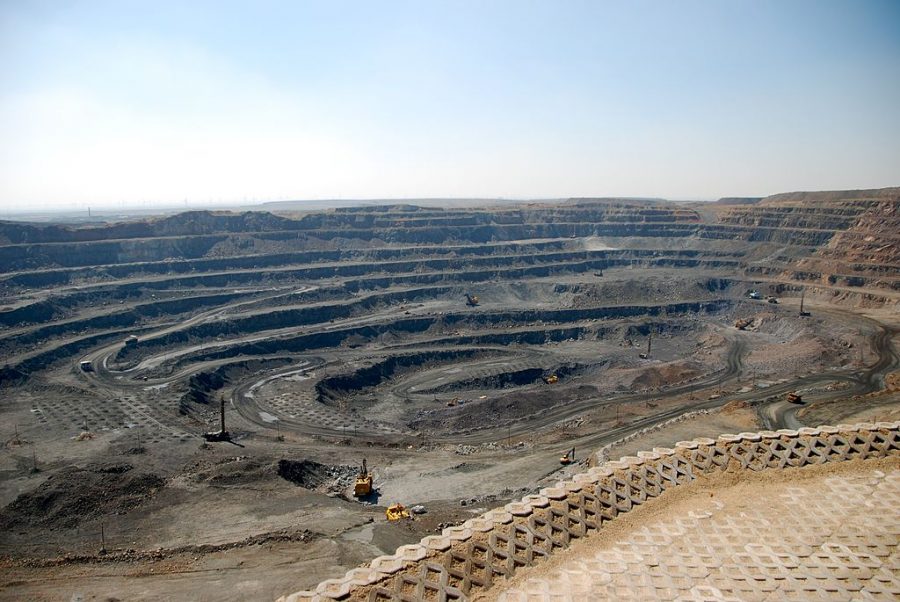
China’s dominance of the rare-earths industry is the result of a 40-year campaign by the Chinese state that has given it a market share of between 80% and 90% of the mining, processing and manufacturing of the minerals and their end-use products.
Rare earths are a tiny market worldwide—the total value of mine production is only around US$4 billion—but their uses in high-technology applications have multiplied over the past two decades.
China had been mining rare earths since the 1950s as a by-product from an iron ore mine, Bayan Obo, in Inner Mongolia. It set up a research institute into rare earths near the mine site in the early 1960s, but it remained an essentially cottage industry until the 1970s, when a Chinese chemical scientist, Xu Guangxian—who had played a key role in China’s nuclear program—developed a method of separating the various rare-earth elements, which are usually found combined in the ore.
Production of rare earths from the Bayan Obo mine soared from 1,000 tonnes in the late 1970s to 11,860 tonnes by 1986, which surpassed production in the United States.
The 1970s and the early 1980s were a period of intense resource nationalism around the world. OPEC was formed, and producer groups, with varying aspirations to control market prices, were established in the bauxite, copper, tin, uranium, phosphate and iron ore industries.
As the Cultural Revolution subsided and the administration of Deng Xiaoping began focusing on China’s economic development, exploiting natural resources and adding value to them became a priority. In 1986, Deng approved a national high-tech research and development plan to help China ‘to gain a foothold in the world arena; to strive to achieve breakthroughs in key technical fields that concern the national economic lifeline and national security; and to achieve “leap-frog” development in key high-tech fields in which China enjoys relative advantages or should take strategic positions’.
In 1992, on a visit to inner Mongolia and the rare-earths district of Baotou, Deng famously commented:
The Middle East has its oil, China has rare earth: China’s rare earth deposits account for 80 percent of identified global reserves, you can compare the status of these reserves to that of oil in the Middle East: it is of extremely important strategic significance; we must be sure to handle the rare earth issue properly and make the fullest use of our country’s advantage in rare earth resources.
China’s mercantilist approach to rare earths was reinforced by Deng’s successor Jiang Zemin, who, on a similar visit to Baotou in 1999, declared that China’s task was to ‘improve the development and application of rare earth, and change the resource advantage into economic superiority’.
China’s production of rare earths rose strongly, reaching 50,000 tonnes by 1996 and 120,000 tonnes by 2010.
At least 40% of China’s output was ‘illegal’ production by small-scale entrepreneurs in the south of China who found they could extract rare-earth oxides from clay soils either with strip mining or by soaking trenches with sulphuric acid.
Efforts to shut down these operations, which cause extensive environmental damage, have been only been partially successful, in a striking reminder that the power of the monolithic Chinese state diminishes with the distance from Beijing.
While building its own production, China has also sought to control the output of rivals. In 2005, the China National Offshore Oil Corporation bid US$18.5 billion for the US oil business Unocal. Unocal had large proven oil and gas reserves in Asia which were attractive to the Chinese oil company. Unnoticed during the heated US debates over the bid was that Unocal also owned the only rare-earths mine in the US, Mountain Pass (it was mothballed at the time). CNOOC’s bid raised a political storm in the US which ultimately led it to withdraw.
In May 2009, China Non-Ferrous Mining Company offered Australian rare-earth developer Lynas a financial lifeline after its funding had been torpedoed by the global financial crisis. The Chinese company would buy 52% of Lynas for $252 million and would provide guarantees for a further US$184 million debt package, which would be sourced from China. CNFMC would take four of the eight board seats and be guaranteed a share of its output.
Treasurer Wayne Swan had taken the papers from the Foreign Investment Review Board recommending that the offer be accepted with him to a meeting of the International Monetary Fund in Washington. Swan had earlier signed off on an FIRB recommendation that he approve the purchase by Chinese investors of a 25% stake in another rare-earths prospect, Arafura, which had also lost access to funding following the financial crisis.
In the US, Swan was startled to read a New York Times report detailing China’s dominant stake in the global rare-earths market. He then asked the FIRB to reconsider the Lynas deal. It came back, suggesting a maximum Chinese shareholding of no more than 49.9% and less than half the directors, leading the Chinese to withdraw their bid. Lynas was eventually developed with Japanese government finance.
The most striking example of the Chinese state seeking integrated control of the rare-earths industry was its 1997 purchase of the General Motors subsidiary Magnequench, which had, in the early 1980s, developed and patented the technology for making permanent magnets using the rare earth neodymium (Japan’s Sumitomo Metals patented a different method for making rare-earth magnets at the same time).
In the mid-1990s, GM was going through a period of corporate restructure, shedding ‘non-core’ subsidiaries, and the magnet-making firm was sold to a joint venture of two Chinese state-owned firms for US$70 million. The sale was controversial—regulators demanded a commitment that the Chinese buyers would retain the assets of the business in the United States for at least five years. There were suggestions the sale helped GM gain permission to establish an assembly line in China.
The buyers were impeccably connected: the new Chinese chairman of Magnequench, Hong Zhang, was married to the daughter of Chinese leader Deng Xiaoping, Deng Nan. Under its Chinese ownership, the firm established a parallel permanent magnet-manufacturing business at Tianjin in China. In 2002, the day after the five-year commitment expired, the US manufacturing operations were closed and the entire plant was shifted to China. The US has only regained a fraction of its capacity to manufacture rare-earth magnets.
Chinese investors remain active in securing stakes in rare-earth prospects around the world, including in listed Australian rare-earths companies Arafura and Northern Minerals.
Fears that China may use its dominant position as a weapon in its trade war with the US were sparked when China’s president Xi Jinping visited the leading rare-earths miner and magnet manufacturer JL Mag in June this year, a few days after the US had announced it would ban the export of technology-sensitive products to Chinese telecommunications giant Huawei.
He said rare earths were an important strategic and non-renewable resource, but he emphasised the importance of adding value through their application. ‘We should firmly grasp the strategic basis of technological innovation, master more key core technologies and seize the commanding heights of industry development’, he said.
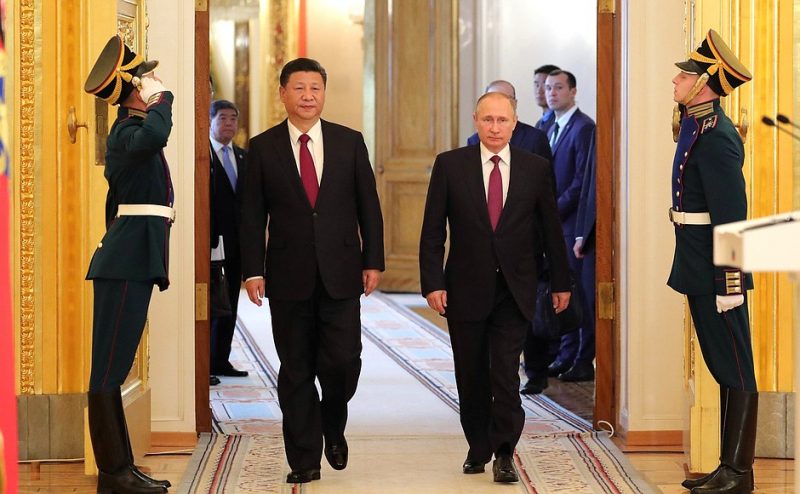
China and Russia have not only expanded their military cooperation but are also undertaking more extensive technological cooperation, including in 5G, artificial intelligence, robotics, biotechnology, new media and the digital economy.
In our new report, A new Sino-Russian high-tech partnership: authoritarian innovation in an era of great-power rivalry, published today by ASPI’s International Cyber Policy Centre, we map out the unique ecosystem underpinning expanding technology cooperation between Moscow and Beijing.
Sino-Russian relations have been adapting to an era of great-power rivalry. This complex relationship, categorised as a ‘comprehensive strategic partnership of coordination for a new era’, has continued to evolve as global strategic competition has intensified. When Russia and China commemorated the 70th anniversary of the establishment of diplomatic relations between the Soviet Union and the People’s Republic of China in October 2019, the celebrations highlighted the history of this ‘friendship’ and a positive agenda for contemporary partnership that is pursuing bilateral security, ‘the spirit of innovation’, and ‘cooperation in all areas’.
This rapidly emerging ecosystem shows that Beijing and Moscow recognise the value of joining forces in the development of dual-use technologies—which possess clear military and commercial significance. This cooperation is growing across five key areas: dialogues and exchanges; the development of industrial science and technology parks; the expansion of academic cooperation; joint investment funds; and the promotion of joint competitions.
The distinct deepening of this relationship is also a response to increased pressures imposed by the US. Over the past couple of years, US policy has sought to limit Chinese and Russian engagements with the global technological ecosystem, including through sanctions and export controls. Under these geopolitical circumstances, the determination of Chinese and Russian leaders to develop indigenous replacements for foreign, particularly American, technologies, from chips to operating systems, has provided further motivation for cooperation.
These advances in authoritarian innovation should provoke concerns for democracies for reasons of security, human rights and overall competitiveness. Notably, the Chinese and Russian governments are also cooperating on techniques for improved censorship and surveillance and increasingly coordinating on approaches to governance that justify and promote their preferred approach of cyber sovereignty and internet management to other countries and through international standards and other institutions. Today’s trends in technological collaboration and competition also possess strategic and ideological implications for great-power rivalry.
It will be important to track the trajectory and assess the implications of these Sino-Russian technological collaborations, given the risks and threats that could result from those advances. In a world of globalised innovation, the diffusion of even the most sensitive and strategic technologies, particularly those that are dual-use in nature and driven by commercial developments, will remain inherently challenging to constrain but essential to understand and anticipate.
To avoid strategic surprise, it’s important to assess and anticipate these technological advancements by potential adversaries. Like-minded democracies that are concerned about the capabilities of these authoritarian regimes should monitor and evaluate the potential implications of these continuing developments.
The US and Australia, along with allies and partners, should monitor and mitigate tech transfer and collaborative research activities that can involve intellectual property theft and extra-legal activities, including through expanding information-sharing mechanisms. This collaboration should include coordinating on export controls, screening of investments, and restrictions against collaboration with military-linked or otherwise problematic institutions in China and Russia.
It’s critical to continue to deepen cooperation and coordination on policy responses to the challenges and opportunities that emerging technologies present. For instance, improvements in sharing data among allies and partners within and beyond the Five Eyes nations could be conducive to advancing the future development of AI in a manner that’s consistent with our ethics and values.
Today, like-minded democracies must recognise the threats from advances in and the diffusion of technologies that can be used to empower autocratic regimes. For that reason, it will be vital to mount a more unified response to promulgate norms for the use of next-generation technologies, particularly AI and biotech.
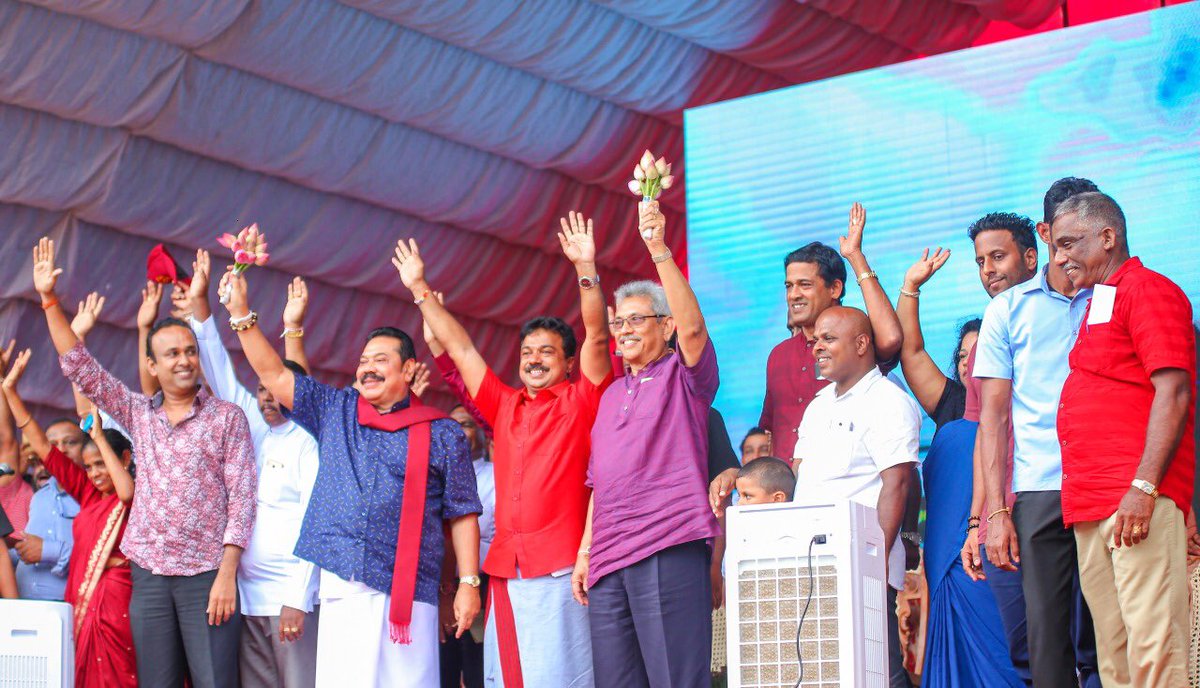
One of Asia’s oldest democracies may be in jeopardy. Sri Lanka’s presidential election next month is expected to bring to power another member of the Rajapaksa family, whose affinity for authoritarianism, violence and corruption is well known. While Sri Lanka’s democracy survived the last test—an attempted constitutional coup by outgoing President Maithripala Sirisena a year ago—it may not survive a Gotabaya Rajapaksa presidency.
Gotabaya, as he’s popularly known, is the current frontrunner and previously served as Sri Lanka’s defence chief under his older brother Mahinda Rajapaksa, Sirisena’s predecessor. Mahinda’s decade-long tenure, which ended in 2015, was characterised by brazen nepotism, with the four Rajapaksa brothers controlling many government ministries and about 80% of total public spending. And by steadily expanding presidential powers, Mahinda created a quasi-dictatorship known for human-rights abuses and accused of war crimes.
Moreover, Mahinda’s pro-China foreign policy allowed for the swift expansion of Chinese influence in Sri Lanka—and rapid growth in Sri Lankan debt to China. It was the debt incurred during the last Rajapaksa presidency that forced Sirisena in 2017 to sign away to China the Indian Ocean’s most strategic port, Hambantota, along with 6,070 hectares (15,000 acres) of nearby land, on a 99-year lease. This Hong Kong–style concession was modelled on the United Kingdom’s 19th-century colonial imposition on China.
There’s little reason to doubt that Gotabaya would revive his brother’s corrosive legacy. Simply by becoming president, he could gain immunity from two lawsuits pending in US federal court over war crimes allegedly committed while he was Sri Lanka’s defence chief. (With the parliament’s restoration of presidential term limits prohibiting Mahinda from running again, Gotabaya renounced his US citizenship to become eligible to contest the election.)
Mahinda oversaw the end of Sri Lanka’s brutal 25-year civil war in 2009. But he was no agent of peace. During the war’s final years, thousands of people—from aid workers and Tamil civilians to the Rajapaksa family’s political opponents—disappeared or were tortured. And the final military offensive against the Tamil Tiger rebels was, according to the United Nations, a ‘grave assault on the entire regime of international law’, with as many as 40,000 civilians killed. According to the wartime military commander, Sarath Fonseka, Gotabaya ordered the summary execution of rebel leaders as they surrendered.
Despite the horrors they inflicted on Sri Lanka’s mostly Hindu Tamil minority, the Rajapaksa brothers became heroes to many among the country’s largely Buddhist Sinhalese majority. That emboldened Mahinda to step up efforts to fashion a mono-ethnic identity for a multiethnic country.
Renewing this approach, as Gotabaya is sure to do, will hardly ease the sectarian divide that triggered the civil war, let alone more recent tensions between the Sinhalese and Sri Lanka’s Muslims. Those tensions increased sharply in April, when Islamist militants carried out a series of bombings on Easter Sunday that killed 253 people and wounded hundreds more.
Not only was this one of the deadliest terrorist attacks in history, it was also the first major Islamist militant attack that Sri Lanka, where Muslims constitute one-tenth of the population, had ever experienced. But that doesn’t mean it was unforeseeable.
In fact, Sirisena admitted that defence and police officials had received an Indian intelligence report warning of an imminent attack and identifying the plotters, but that he had not seen it. Nor did Prime Minister Ranil Wickremesinghe—the target of Sirisena’s attempted coup last October—receive the warning. (Sirisena abruptly fired Wickremesinghe and swore in none other than Mahinda Rajapaksa, before dissolving parliament to avoid a challenge. His actions were reversed when the supreme court ruled them unconstitutional.)
The Rajapaksas have already used the Islamist bombings to fan the flame of Sinhalese nationalism. And Gotabaya has promised his supporters that, if elected, he will strengthen the intelligence services and reintroduce surveillance of citizens, in order to crush Islamist extremism. The prospect of an alleged war criminal still wedded to extrajudicial methods becoming president rightly terrifies minority groups, the media and civil-liberties advocates.
There’s more worrisome news, though. Gotayaba’s camp has also confirmed that, as president, he plans to ‘restore relations’ with China. Given Sri Lanka’s strategic location near the world’s busiest sea lanes, the implications of this pledge extend well beyond the island. Indeed, Sri Lanka could play a pivotal role in the struggle for maritime primacy between China and Indo-Pacific democratic powers (India, the United States, Japan and Australia). China’s ‘string of pearls’ strategy has been encircling India by securing strategic military and commercial facilities along major Indian Ocean shipping lanes. The Hambantota port, which Chinese President Xi Jinping described as central to his Maritime Silk Road project, is a particularly valuable pearl.
At a time of growing international skepticism toward Xi’s Belt and Road Initiative, the Rajapaksa family’s potential return to power in Sri Lanka is welcome news for China, which hopes to turn the country into a military outpost. But it’s bad news for practically everyone else. A Gotabaya presidency would block already-delayed justice to victims of his brother’s regime, deepen ethnic and religious fault lines, and help China gain strategic supremacy in the Indo-Pacific. Sri Lankan democracy appears more vulnerable than ever.
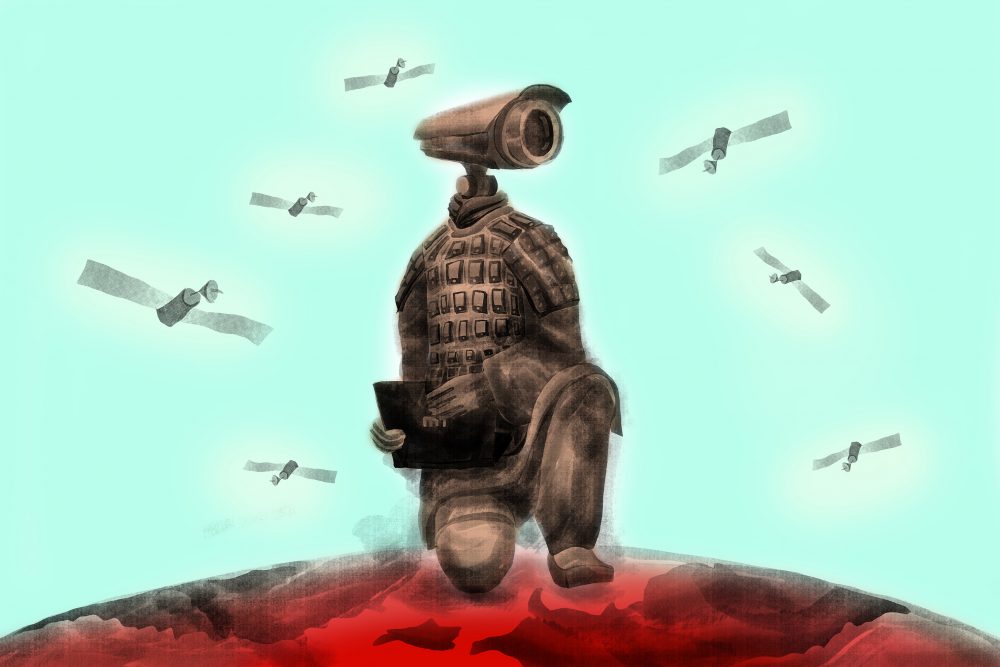
The Chinese party-state’s technology-enhanced authoritarianism is expanding globally. But the way it’s doing it isn’t always distinctly coercive or overtly invasive. While there’s been an important focus on technologies such as 5G, surveillance and cyber-enabled espionage, that narrow view misses the bigger picture. The Chinese Communist Party has a much more ambitious vision for harnessing a broad suite of current and emerging technologies in support of its own interests, including some that might seem relatively benign, like language-translation technologies.
By leveraging state-owned enterprises, Chinese technology companies and partnerships with foreign entities—including Western universities—the CCP is building a massive data-collection enterprise that gives it control over large data flows.
For the Chinese party-state, data-gathering is a means of generating information to enhance state security—and, crucially, the political security of the CCP—across multiple domains. The party-state intends to shape, manage and control its global operating environment so that public sentiment is favourable to its own interests. The CCP’s interests are prioritised over the Chinese state’s interests and the Chinese people’s interests. The effort requires continuous expansion of the party’s power overseas because, according to its own articulation of its threat perceptions, external risks to its power are just as likely—if not more likely—to emerge from outside the People’s Republic of China’s borders as from within.
As this approach continues to take shape, many Western governments will find themselves both struggling to understand the problem and struggling to respond.
A new report from ASPI’s International Cyber Policy Centre uses the company Global Tone Communications Technology (GTCOM) as a case study to explain how this new phenomenon can work. GTCOM is a subsidiary of a Chinese state-owned enterprise that the Central Propaganda Department directly supervises. It provides both hardware and software translation tools. GTCOM describes itself as a ‘cross-language big data’ business: it collects bulk data globally in more than 65 languages and processes it for output into other products and services for government and corporate clients. The products can be applied to tools that have global implications, such as parts of China’s social credit system.
GTCOM claims to collect ‘billions’ of pieces of globally sourced unstructured data. Through just one of its many platforms, focused on traditional and social media, GTCOM claims to gather 10 terabytes of data a day (equivalent to 5 trillion words of plain text) as part of its ‘cross-language big data’ business, and 2–3 petabytes a year (equivalent to 20 billion photos on Facebook). Anything translated by the company’s translation services is part of the bulk data it collects.
The company uses bulk data collection and artificial intelligence processing of data for information platforms and tools provided to the party-state. Such tools include propaganda, intelligence, social credit system–linked creditworthiness determination products, and government services.
As GTCOM is a company openly contributing to state security and intelligence data collection, the case study sheds light on many other issues that should be of critical importance to global decision-makers. It demonstrates, for instance, the global consequences of the PRC’s military–civil fusion priority, which ‘seeks to break down the barriers between China’s civilian and military sectors’.
National and local governments across the globe—under liberal and illiberal regimes alike—are choosing to buy technologies from PRC companies such as GTCOM’s strategic partners Alibaba Cloud and Huawei. For instance, ASPI’s Mapping China’s technology giants report conducted research into 75 smart city projects around the world, most of which involved Huawei. Many of those projects include more coercive and overtly invasive technologies, such as surveillance cameras and facial and numberplate recognition technologies, but they can also include services like smart transportation and smart parking meters.
Companies such as GTCOM and its strategic partners can simultaneously act in their best interests to provide services and generate profits and to support the party-state’s larger objectives. After all, it’s the party-state that allows them to operate. No single PRC-based actor is shielded from the reality of the CCP’s suite of state security legislation, which delivers the consistent message that every individual and entity is responsible for state security.
While ideal solutions to this emerging set of problems don’t exist yet, partly because research on these issues hasn’t been in-depth or forward-looking, there are a range of areas that governments should be investing in and working with industry and civil society on. The report recommends strengthening data privacy laws and foreign influence transparency schemes. It also recommends greater investment in data literacy and data transparency programs, and calls for a rethink of how governments deal with foreign propaganda in the digital age.